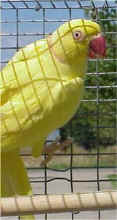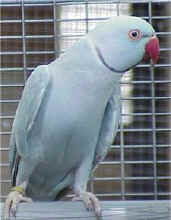|
BREEDS
& THEIR NEEDS
Ring
Necks
| |

|
 
|
|
Normal Green |
Lutino |
Blue cinnamon
Cockbird Blue-split cinnamon |
DISTRIBUTION in the WILD :
The Ring- Parakeet species includes the Indian Ringneck and the African Ringneck
subspecies.
-
They can be found throughout Asia and parts of Africa, including
India, China, Ceylon, Tibet, Nepal and many adjacent islands.
-
The
Indian Ringneck
Parakeet originated in Ceylon.
-
The
African Ringneck
Parakeet, it's close cousin, is found in regions between West Africa to the Southern Sudan.
DESCRIPTION of the SPECIES
:
-
The normal coloration of the male Indian
Ringneck Parakeet is a general green with it's lower abdomen area being
lighter and the back of the head has a bluish tint.
-
A black ring runs through
the chin and along the cheek.
-
There it blends into a pink collar with some blue
on the nape.
-
The central tail feathers are bluish, tipped with a yellow green.
-
The outer tail feathers are green.
-
The beak is plum-red to an almost black
on the tip.
-
Through domestic breeding, there is a large variety of
colour variations, or mutations available.
-
Have a look at the photos at the top of the page to see some of the
colours available.
-
The female and immature male has no black ring, pink
collar, or blue tint on the back of the head.
-
The young can be sexed better after reaching their adult plumage after their second
full moult, around 3 years old.
-
If you want to sex them earlier then you need to DNA
test them.
-
You can either pluck a fresh feather from the birds' chest
or send off for a DNA Kit to take a blood sample.
-
The
African Ringneck
Parakeet is very similar in colouration to the Indian Ringneck,
however it's collar markings are less prominent and it has a smaller beak.
-
Also,
it's tail is two or three inches shorter, making it's overall length shorter.
-
African Ringnecks grow to a length of 16" (40
cm)
-
Indian Ringnecks grow to approx. 14"
CARE & FEEDING :
-
In the wild, they eat a variety of seeds, berries, fruits, nuts, blossoms, and
nectar.
-
In addition to these foods, you can offer them
fruit and veg.
-
They also enjoy the same nutritional foods humans
eat, including cooked chicken.
-
An occasional millet spray is a nice treat.
-
Cuttlefish bone, iodine nibbles block and mineral +
oystershell Grit should always be freely available, esp. important in the
time leading up to Breeding.
-
Some Indian Ringnecks do not enjoy bathing.
-
If
your Ringneck does not like to bathe it should be misted weekly.
-
Some do love to
bathe, however, and individuals that do enjoy water should be provided with
baths frequently.
-
It's good for their plumage quality.
HOUSING:
- Chewing is a natural prelude to bringing the birds into breeding condition.
SOCIAL BEHAVIOUR :
- In the wild, these birds live in flocks and are very social.
- They have a
pleasant nature but will develop a screaming habit if teased. (this is more
relevant in a cage environment rather than in an Aviary).
- The Ringneck Parakeet is clever! Besides learning to talk, these parakeets are
known to be great at learning tricks.
- Some have been taught to string beads on a
rope, twirl sticks about their head, ring a bell, and pick up selected objects.
BREEDING :
- Unlike many parakeets, Ringneck Parakeets do not bond with a mate for life.
- But they are fairly easy to breed, so long as you provide the right
environment at the right time of year.
- Ringnecks are one of the first species of parrot to breed each year.
- They are very hardy birds and have even been seen living in the bleak, snow-covered
landscape of the Himalayan Mountains.
- They also seen living wild in the south of England.
- Start to offer your Ringnecks their nest boxes fairly
soon after Xmas, if you wait until your other birds are thinking of going
to nest, you will have missed the "moment".
- The Hens are the dominant partner throughout most of
the year, apart from the period leading up to breeding. Only at
this time will the cock bird overcome his natural reserve and mate with the hen,
so if you miss this period you are likely to end up with
infertile eggs!
- Each pair will need two nesting boxes to choose from.
-
Nest
boxes
should be deep - approx 2ft - 2ft 6" and approx. 10 -12" square.
- See
Easibed
for wood chip to give them a good deep base.
- The Nestbox should be of stout construction to help keep
the interior warm as possible, for the hen bird and chicks, esp. if the
weather should be very cold.
- Make sure you place the N.box in a
sheltered place and as high as is conveniently manageable.
- Once the nest box is selected the female will lay :
- No. of EGGS in Average Clutch : 3 - 6 eggs.
- INCUBATION : is between 22 and 24 days
- FLEDGING : The young will leave the
nest approx. 6 - 7 weeks after they hatch.
- CLOSE RING : @ 10 - 14 days - Usually
when eyes have started to open & are approx 1/2 open.
- RING SIZE : Sn (for the Indian
Ringneck)
- as the African Ringneck is a slightly bigger bird, it may need a bigger
ring ??
- RING SIZE for the ALEXANDRINE Parakeet
: T
- Alexandrine Parakeets can go to nest early too - usually fairly
soon after the Ring necks.
-
POTENTIAL PROBLEMS :
- These parakeets can have a loud scream and are therefore not really
"close-neighbour-friendly".
|